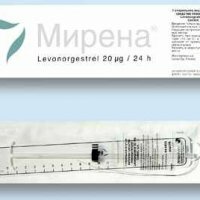Spiral Mirena: effectiveness, contraindications, side effects

The Mirena spiral is made in the form of a T-shaped frame, after the spiral is installed, a levonorgestrel hormone is injected daily into the blood, which is supplied in a certain amount. This hormone is found in all the latest contraceptives. If you define this spiral, it can be called a local contraceptive, it lasts very long, up to 5 years, but then must necessarily be removed or replaced.
How it works
Actually, as in the case with other contraceptives like hormonal, oral drugs or injections, the Mirena spiral works on the same principle. The work is based on the timely stop and prohibition of ovulation, so that the egg does not leave the ovary, as a result of which the fetal egg will not connect and fertilization will not occur.
Is this effective
This spiral is recognized as very effective and reliable, in addition, it is capable of working for five years. For example, it should be said that out of 1000 women who used the Mirena spiral, the case when the spiral did not work, was noted only in two women. The most important point is that after the extraction of the spiral, you do not need to stabilize for a long time, fertility comes at once. Although there are cases of a longer period of up to six months, but this is an exception to the rules. Spiral does not protect women from sexually transmitted diseases, which are transmitted through sexual intercourse.
Side effects of
If there is some incompatibility of the body and the Mirena spiral, then they are detected in the first months after installation, but then the body gets used, and such symptoms pass without any treatment. Of the known side effects noted:
- decrease in the intensity of menstrual flow, and also the cycle time becomes shorter;
- there is a headache;
- can cause acne on the skin;
- weight gain;
- nausea;
- appearance of a cyst on the ovaries;
- sudden dizziness;
- mammary glands become sensitive;
- sudden changes in mood.
Of the above, everything passes quickly enough, but here the problem with the menstrual cycle can remain.
Contraindications to installation of
For chronic diseases and infections or in the presence of malignant education, the examination and conclusion of a specialist is necessary.
The following are the obvious moments with a contraindication:
- individual intolerance of components;
- tumors of malignant properties in the cervix or uterus;
- with deep vein thrombosis on the legs, even if it is in the past;
- if there was breast cancer;
- inflammation of the pelvic organs;
- if there are diseases that are highly susceptible to infection;
- in case of pregnancy;
- anomalies of any character in the uterus;
- endometritis, including postpartum;
- infection in the genitourinary tract;
- bleeding of the uterus;
- cervical dysplasia;
- for the church;
- after an abortion for three months;
- in the case of hepatic disease, hepatitis, cirrhosis, jaundice.
Mandatory conditions for the introduction of the spiral Mirena
The installation should be performed only by a specialist with sufficient experience. The spiral should be placed in the uterine cavity immediately after the menstrual cycle or within seven days. If the timing is tight, then you first need to determine whether there is any pregnancy and only then to install a contraceptive. Within a week, until confirmation is confirmed, you need to either limit your sex life, or use additional contraceptives. After 5 years, replace the spiral or remove it.
If a woman has recently given birth, then the spiral can be established only after 6 weeks, not earlier, and only after the completion of the process of uterine involution. It is also necessary to prevent postpartum endometritis, for this purpose it is necessary to observe the rate of contraction of the uterus. In the case where there are violations, it is necessary to push the spiral unit up to the restoration of the uterus. If there was an abortion, spontaneous or artificial, then the spiral should be installed after the examination and making sure that there is no infection, do this at least a week later.
There are times when the installation of the spiral is difficult for some reason, it may be because of the bleeding that has opened during installation or immediately after installation, as well as in case of severe pain during installation. In these cases, it is impossible to establish a spiral, but it is also not necessary to leave the case, it is necessary to conduct an ultrasound study or a physical method. The fact is that the cause of such pain and bleeding may be mechanical damage to the uterus.
Removal of the spiral Mirena
After the installation of the Mirena spiral, it must be removed, this is done during the menstrual cycle, the spiral is extracted using special forceps that grab the spiral by the threads and pull it out. If a woman considers it necessary to prolong the use and there are no known contraindications, then you can immediately put a new spiral. If the spiral was not removed in the menstrual cycle, then to install a new spiral, a woman should use other types of contraceptives within a week prior to removal. If a woman has amenorrhea, then barrier contraception is mandatory, it must be done one week before the Mirena spiral is removed and before menstruation.
After the removal, the specialist conducts a thorough examination of the intrauterine contraceptive itself to make sure that it is not damaged and removed completely. There were cases when the hormone-elastomeric core slid, as a rule, it happens with a difficult removal, in this case part of the T-shaped structure remained in the core. If the spiral is removed completely and without residues, then no additional cleaning is necessary, but quite often horizontal stops make it difficult to remove the core.
With regard to the frequent use of the Mirena spiral, it has already been tested and proven that the contraceptive can be used without problems for health two times in a row.
Use in breastfeeding and pregnancy
You can not use the Mirena spiral, like other hormones, when you are pregnant or even suspected of it. In case of pregnancy due to a fallen spiral, it must be removed, otherwise the risk of premature birth or arbitrary abortion is high. This should be done by an expert and very carefully, with careless actions, an arbitrary abortion can occur.
If you use the Mirena spiral after childbirth after 6 weeks, this will not affect the development of the fetus and the growth of the baby. If it carries gestagenamnu monotherapy, this will not affect the quality of breast milk in any way, so you can safely install the spiral nursing.
Problems and complications
Given the quality of this spiral, problems with various complications after installation do not happen. If symptoms are not peculiar to you, then you should contact specialists and do not delay.
Very rarely, but there were cases when using marked perforation of the uterus, ectopic pregnancy, intrauterine system dropped out or there were infections. It is also worth noting that the Mirena spiral does not contribute to infertility or the development of pelvic organs.

